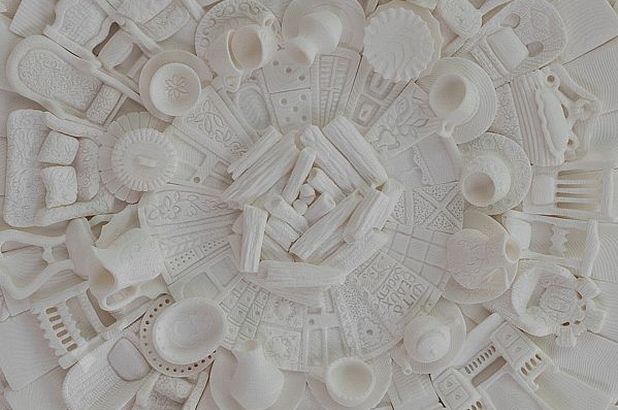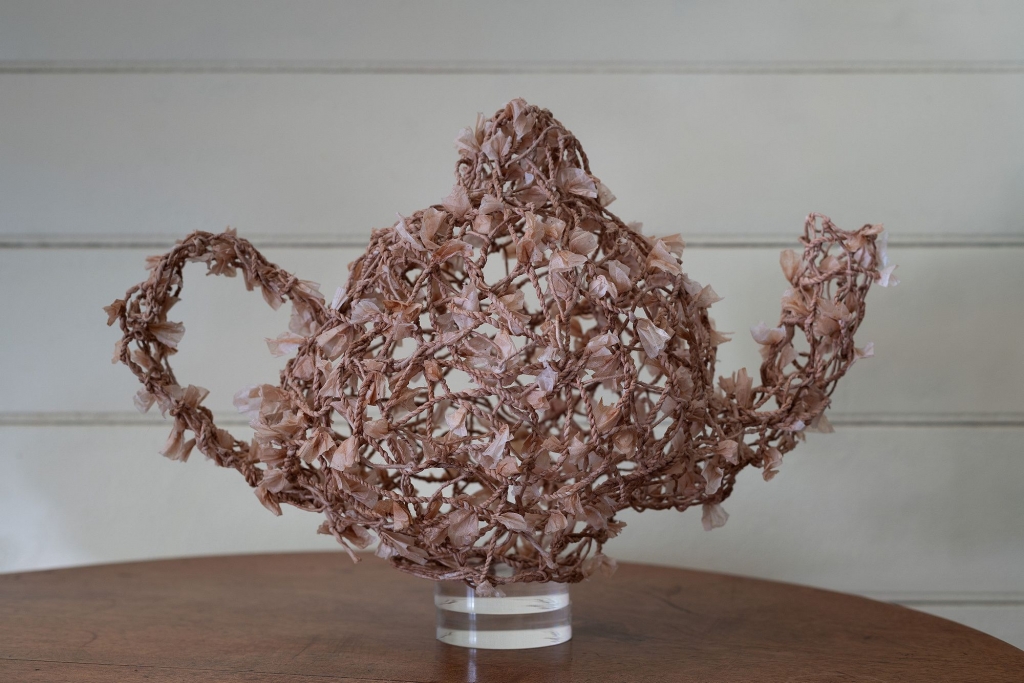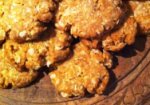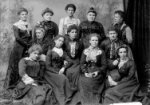The restorative power and ritualised nature of tea, whether elegantly poured from a pot into a fine china cup, or a bag languishing in a mug on a kitchen bench or work-desk gives inspiration to many of the artists who have entered works in the Meroogal Women’s Art Prize.
The works below give just a taste of the 35 finalist entries that are being exhibited in the historic house of Meroogal and its garden and grounds until March 30, 2019, throwing new light on the stories of the people who lived there and the houses rich collection of objects. They are broad in scope, artistic style and media – from soap to stale bread, insects to cuttlefish, video to used teabags.

Meroogal Women’s Art Prize winners with SLM Directors and distinguished guests at Meroogal. Photo © Tim Pascoe/James Horan for Sydney Living Museums
You can see the judges awards here, and if you visit the exhibition you can make your own decision and enter it into the People’s Choice Award, which will be announced at the International Women’s Day ceremony in March 2019.
Just a taste
The selection below (arranged alphabetically, by the artists’ surnames, with their interpretation notes) concentrates on those that relate to tea – some even make use of spent teabags in their composition – so pop the kettle on Polly and enjoy them with a cuppa!
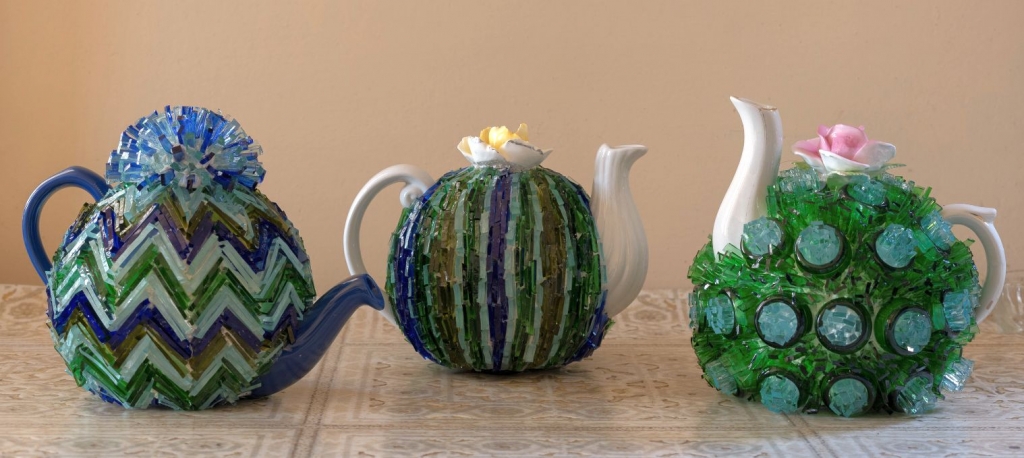
Luba Bosch, ‘A cosy threesome’, Recycled glass bottles, porcelain, ceramic (Installation view, detail) © Nicholas Watt for Sydney Living Museums
Luba Bosch, A cosy threesome, Recycled glass bottles, porcelain, ceramic (above)
“A cosy threesome pays homage to the tradition of the tea party. At Meroogal, these were a monthly event. A welcoming pot of tea enabled stories to be shared. The tea-cosy, as well as being practical in nature, represented an opportunity for creative expression. I chose to create a series of three works in various teapot forms to represent the idea of shared experience as well as to create a sparkling narrative of celebration.”
Kylie Douglas, Womandala, Cuttlefish bone (below)

Kylie Douglas, ‘Womandala’. Cuttlefish bone. (Installation view, detail) Photo © Nicholas Watt for Sydney Living Museums
“The title of this work, Womandala, has two specific meanings – handcrafted entirely by women, and the circle. This mandala represents the core of Meroogal and the energy within and around the house. Each piece is a replica of the tangible objects used and decorated within the property. From the heart of the house, the fireplace, resonating from the centre towards the exterior and finishing with the gardens, Womandala is a complete visual representation of the women of Meroogal.”
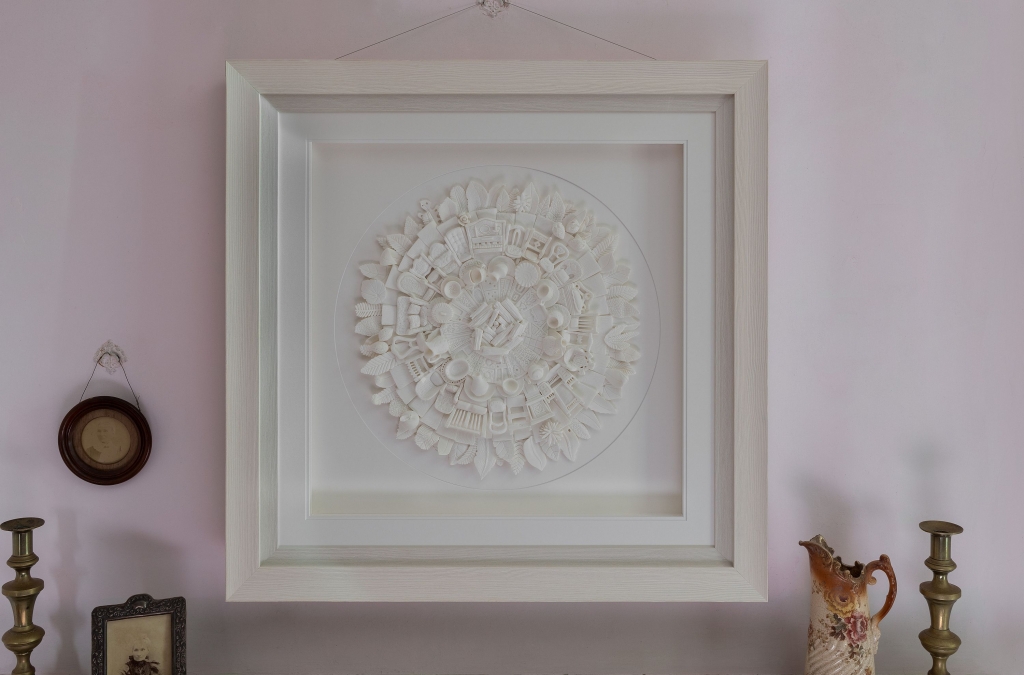
Kylie Douglas, ‘Womandala’. Cuttlefish bone. (Installation view) Photo © Nicholas Watt for Sydney Living Museums
Brenda Livermore, Shall we have tea. Sculpture, salvaged tea bag paper, wire (below).
Brenda Livermoore, ‘Shall we have tea’. Sculpture, salvaged tea bag paper, wire (Installation view). Meroogal Women’s Art Prize 2018 Photo © Nicholas Watt for Sydney Living Museums
“Throughout the lives of the women of Meroogal the humble cup of tea played a significant role. Whether taken in company or while enjoying a quiet reflective moment, it punctuated the day’s activities. At the beginning of the day. At the end of the day. A pause when work was put aside. A cup of tea shared. A conduit for conversation with family, friends and neighbours. Home baking, sharing news and stories, talking over a worry, a joy. Shall we have tea?”
Judith Martinez, The visitants. Reproductions of carte-de-viste photographs from the Caroline Simpson Library and Research Collection, Sydney Living Museums, Perspex, antique porcelain cups (below).
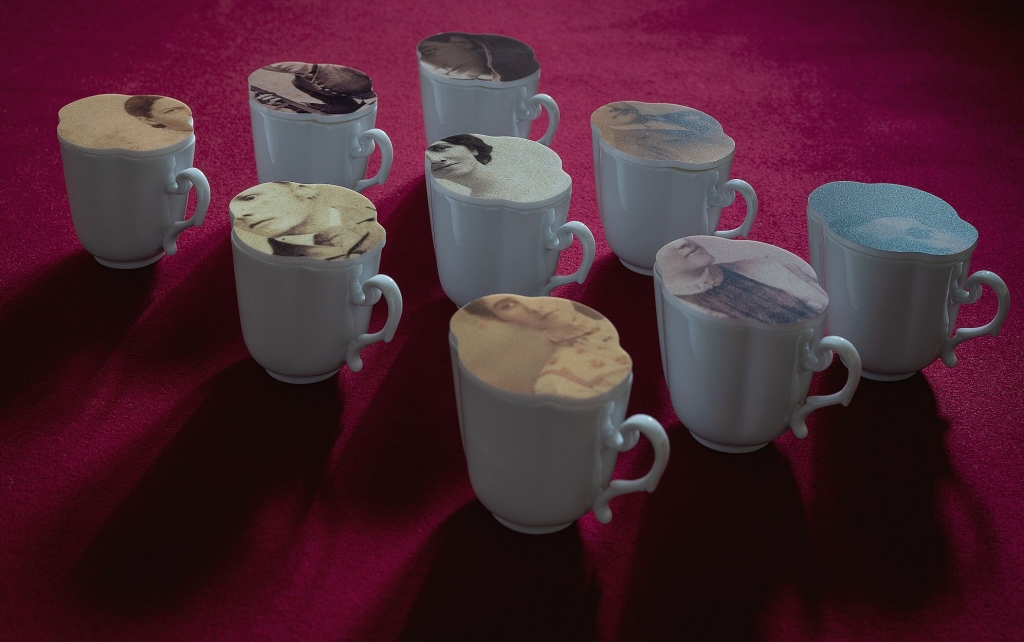
Judith Martinez, ‘The visitants’, Reproductions of carte-de-visite photographs, perspex, antique porcelain cups (Installation view, detail). Photo © Nicholas Watt for Sydney Living Museums
“The visitants pays tribute to the almost forgotten act of visiting and taking tea at an acquaintance’s or relative’s home in this case, Meroogal. These fragments of portraits from the Caroline Simpson Library & Research Collection at Sydney Living Museums suggest elements of lives being exposed through controlled and polite conversation. They become visual maps to follow and decipher, narratives about memory and place, which when combined lead us to the question: who were these people outside of this room?”
Judy Panucci, Keep/Forsake. Used tea bags, stitching, collected moths, dandelions, mixed media (three pieces, below)

Judy Panucci, ‘Keep/Forsake’, Used tea bags, stitching, collected moths, dandelions, mixed media (3 of 3 pieces, Installation view) © Nicholas Watt for Sydney Living Museums
“Evolving from Time shroud (Highly Commended, Meroogal Women’s Art Prize 2016), Keep/Forsake honours the love and work of women throughout time. Based on a diary entry by Tottie Thorburn from 29 February 1888 and a preserved ceremonial gown and bonnet [shown below], shown reverentially to me by current Meroogal guardians, my work questions what we value and what we cast aside. In this living museum, women still cherish, care and curate, against the tide. The symbol of this, an apron, is left to the elements as valued items are preserved.”

Judy Panucci, ‘Keep/Forsake’, Used tea bags, stitching, collected moths, dandelions, mixed media (1 of 3 pieces, Installation view, detail) © Nicholas Watt for Sydney Living Museums
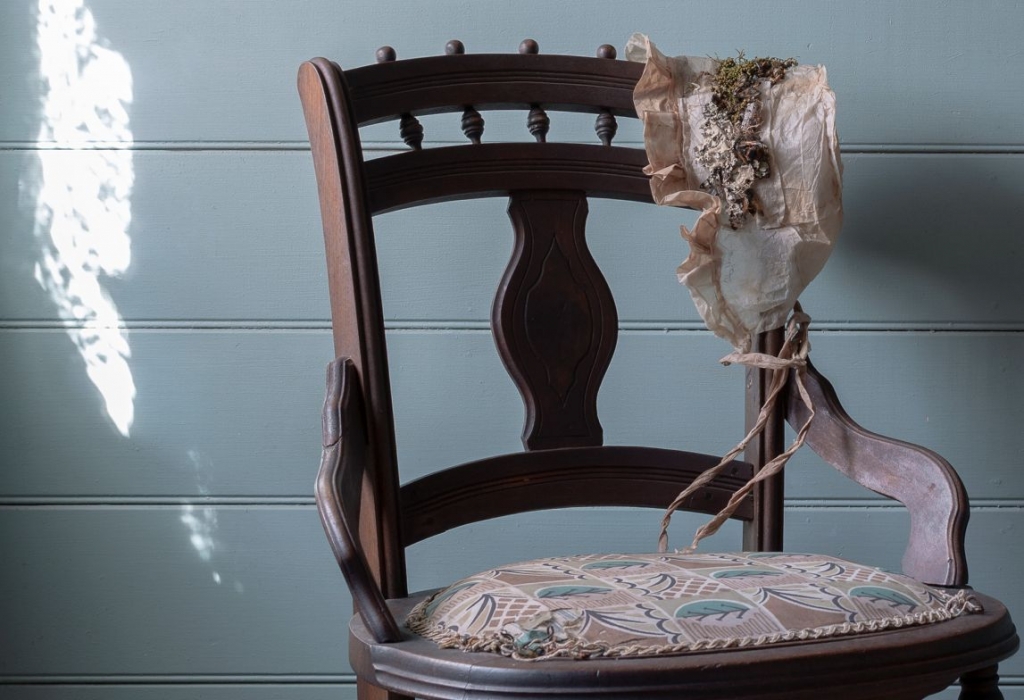
Judy Panucci, ‘Keep/Forsake’, Used tea bags, stitching, collected moths, dandelions, mixed media (2 of 3 pieces, Installation view, detail) © Nicholas Watt for Sydney Living Museums
Sassy Park, Lady, nurse and suffragette. Ceramic (below)

Sassy Park, ‘Lady, nurse and suffragette’, Ceramic (Installation view) Photo © Nicholas Watt for Sydney Living Museums
“The women of Meroogal are the inspiration for this group of ceramic figures. The work responds to the contrary status women held in connection to Meroogals habitation. Decorative objects and artworks on a mantelpiece or in a cabinet fulfil an important function. They communicate history and culture and inform us of status and aesthetics; overall they speak to us. These three figures, standing on plinths derived from the domestic realm, an upturned teacup and terracotta spools, reconsider their positions.”
Extra sustenance
And what is a cup of tea without a little sustenance? The foodie in me can’t resist adding these tasty samples. Regular readers of The Cook & the Curator might recognise the source of the following item by Beth Norling as a recipe from the Meroogal collection.

Beth Norling, ‘Not all things are washed away’. Soap, ink (detail, Installation view). Photo © Nicholas Watt for Sydney Living Museums.
Beth Norling, Not all things are washed away. Soap, ink (above, one of 39 pieces, shown below, which won the Highly Commended award).
“In 1860 the McKenzie family survived a devastating flood in Terara [a town on the banks of the Shoalhaven River], losing everything except the grandfather clock that still stands at Meroogal. My work not all things are washed away explores the question: what is left and what is lost? It depicts things that remain at Meroogal and imagines the moments that are forever gone. The technique of scrimshaw is relevant to the concept: ink is applied then washed away, the excess trapped in the scratches of the image beneath.”
Highly commended, Meroogal Women’s Art Prize 2018 – Beth Norling, Not all things are washed away (Installation view, detail), Soap, ink. Photo © Nicholas Watt for Sydney Living Museums
Sherna Teperson, Soft shuffle through Meroogal. Air-dried bread, PVA, acrylic domes, perspex, silicone sealant, cotton, porcelain plates (below).
“Tottie Thorburns diary relates an incident with Mr Mason, a suitor: I treated him badly I think and felt sorry afterwards. I began to imagine what shoes she might have worn when this incident occurred. Soft shuffle through Meroogal consists of five domed cake stands. Inside are replicas of shoes carved from bread. The Bow shoes express what may have been Tottie’s feelings at the time heart flutter, confusion, disappointment while the others are more practical, better suited to her lifestyle. Air-dried under the domes, the bread shoes are everlasting.”
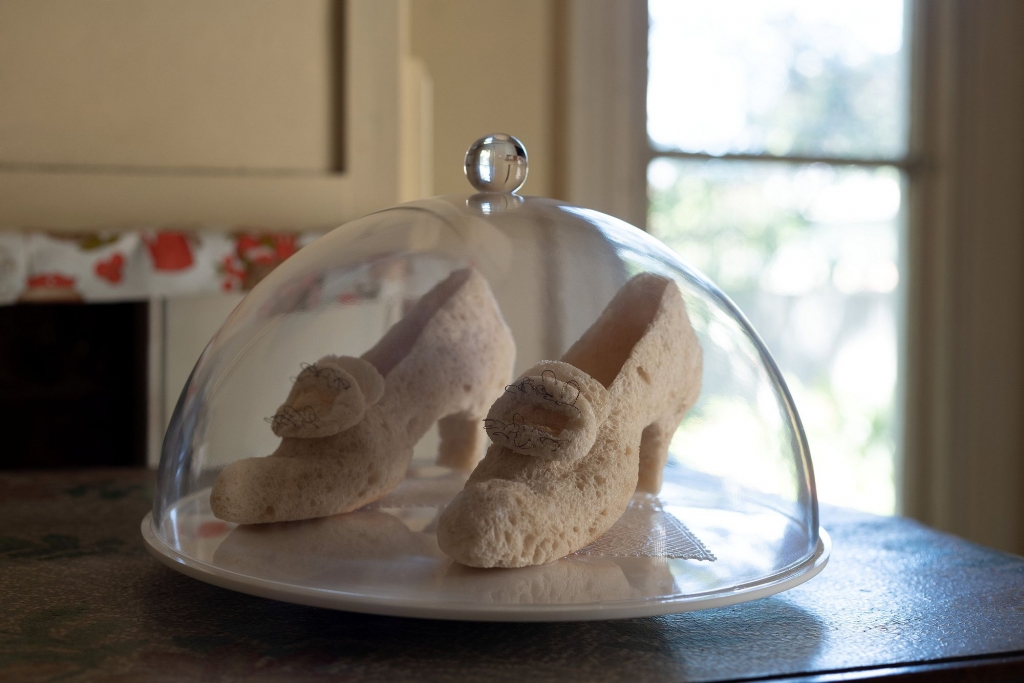
Sherna Teperson, ‘Soft shuffle through Meroogal’, Air-dried bread, PVA, acrylic domes, perspex, silicone sealant, cotton, porcelain plates (detail, Installation view) Photo © Nicholas Watt for Sydney Living Museums
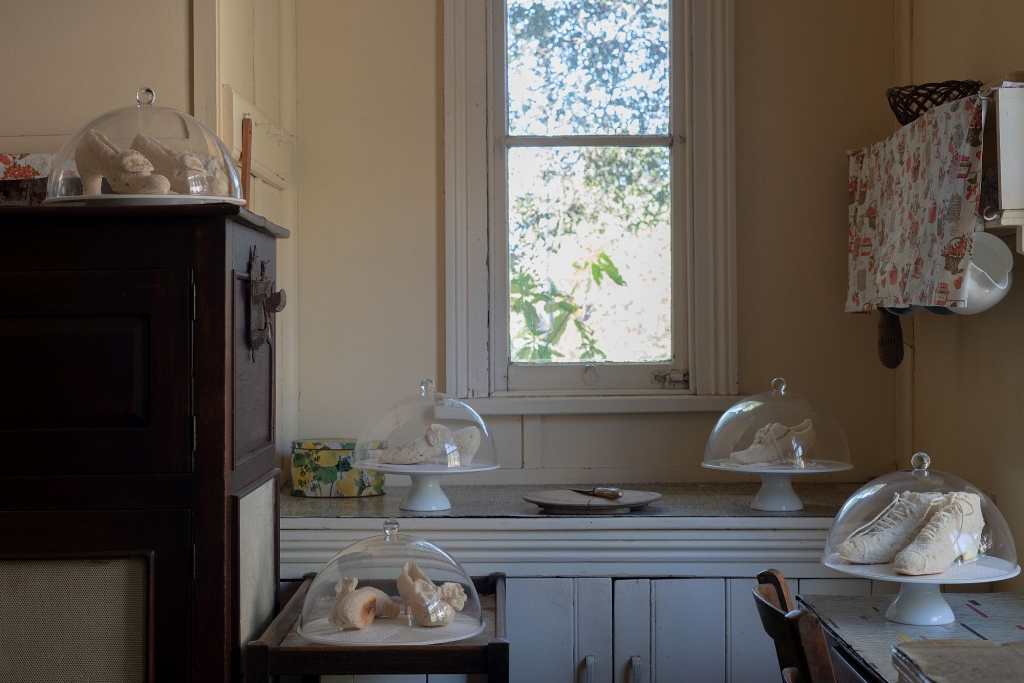
Sherna Teperson, ‘Soft shuffle through Meroogal’, Air-dried bread, PVA, acrylic domes, perspex, silicone sealant, cotton, porcelain plates (Installation view) Photo © Nicholas Watt for Sydney Living Museums
